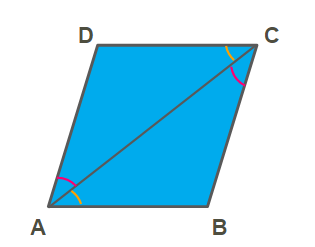
PUMPA - SMART LEARNING
எங்கள் ஆசிரியர்களுடன் 1-ஆன்-1 ஆலோசனை நேரத்தைப் பெறுங்கள். டாப்பர் ஆவதற்கு நாங்கள் பயிற்சி அளிப்போம்
Book Free DemoTheorem I: In a parallelogram, opposite sides are equal.

Given: A parallelogram ABCD with AC as its diagonal.
To prove: \Delta ABC\cong\Delta ADC.
Proof: We know that 'Opposite sides of a parallelogram are parallel'. So, AB||DC and AD||BC.
Since AB||DC & AC is the transversal.
∠BAC =∠DCA (Alternate angle ...1(yellow)).
Since AD||BC & AC is the transversal.
∠DAC =∠BCA (Alternate angle ...2(red)).
In △ABC & △ ADC.
∠BAC =∠DCA (From alternate angle ...1).
∠DAC =∠BCA (From alternate angle ...2).
AC=AC (common in both).
Thus, by the ASA criterion, the two triangles are congruent, which means that the corresponding sides must be equal.
Hence, AB=CD & AD=BC (corresponding parts of congruent triangles).
Hence, it is proved.
Theorem II: A diagonal of a parallelogram divides it into two congruent triangles.

Given: A parallelogram ABCD with AC as its diagonal.
To prove: ΔABC ≅ ΔADC.
Proof: We know that 'Opposite sides of a parallelogram is parallel'. So, AB||DC and AD||BC.
Since AB||DC & AC is the transversal.
∠BAC =∠DCA (Alternate angle ...1(yellow)).
Since AD||DC & AC is the transversal.
∠DAC =∠BCA (Alternate angle ...2(red)).
In △ABC & △ ADC.
∠BAC =∠DCA (From alternate angle ...1).
∠DAC =∠BCA (From alternate angle ...2).
From the above figure, we can write as follows:
∠BAC +∠BCA = ∠DAC + ∠DCA…(1)
Apply angle sum property to the triangle ABC.
∠B+∠BAC+∠BCA =180°…(2)
Now apply angle sum property to the triangle ACD.
∠D+∠DAC+∠DCA=180°…(3)
Comparing (2) and (3) with (1) we have:
∠B = ∠D.
From the theorem I, AB=CD & AD=BC.
Thus, by the SAS criterion, the two triangles ABC and ADC are congruent, which means that the corresponding sides must be equal.
Hence, it is proved.